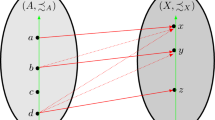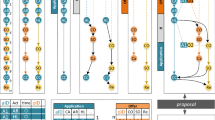Abstract
A sequential effect algebra (SEA) is an effect algebra on which a sequential product is defined. We present examples of effect algebras that admit a unique, many and no sequential product. Some general theorems concerning unique sequential products are proved. We discuss sequentially ordered SEAs in which the order is completely determined by the sequential product. It is demonstrated that intervals in a sequential ordered SEA admit a sequential product.
Similar content being viewed by others
References
Bennett, M. K. and Foulis, D. J. (1997). Interval and scale effect algebras. Advances in Applied Mathematics 91, 200–215.
Busch, P., Lahti, P. J., and Middlestaedt, P. (1991). The Quantum Theory of Measurements, Springer-Verlag, Berlin.
Busch, P. and Singh, J. (1998). Lüders theorem for unsharp effects. Physics Letters A 249, 10–24.
Davies, E. B. (1976). Quantum Theory of Open Systems, Academic Press, New York.
Douglas, R. G. (1966). On majorization, factorization, and range inclusion of operators on Hilbert space. Proceedings of American Mathematical Society 17, 413–415.
Dvurečenskij, A. and Pulmannová, S. (2000). New Trends in Quantum Structures, Kluwer, Dordrecht.
Foulis, D. J. and Bennett, M. K. (1994). Effect algebras and unsharp quantum logics. Foundation of Physics 24, 1325–1346.
Giuntini, R. and Greuling, H. (1989). Toward a formal language for unsharp properties. Foundation Physics 19, 931–945.
Gudder, S. (1998a). Sharply dominating effect algebras. Tatra Mountain Mathematical Publication 15, 23–30.
Gudder, S. (1998b). A histories approach to quantum mechanics. Journal of Mathematical Physics 39, 5772–5788.
Gudder, S. and Nagy, G. (2001a). Sequentially independent effects. Proceedings of American Mathematical Soceity 130, 1125–1130.
Gudder, S. and Nagy, G. (2001b). Sequential quantum measurements. Journal of Mathematical Physics 42, 5212–5222.
Gudder, S. and Greechie, R. (2002). Sequential products on effect algebras. Reports on Mathematical Physics 49, 87–111.
Kôpka, F. and Chovanec, F. (1994). D-Posets. Mathematical Slovaca 44, 21–34.
Kraus, K. (1983). States, Effects, and Operations, Springer-Verlag, Berlin.
Ludwig, G. (1983). Foundations of Quantum Mechanics, Springer-Verlag, Berlin.
Author information
Authors and Affiliations
Corresponding author
Rights and permissions
About this article
Cite this article
Gudder, S., Greechie, R. Uniqueness and Order in Sequential Effect Algebras. Int J Theor Phys 44, 755–770 (2005). https://doi.org/10.1007/s10773-005-7054-y
Received:
Accepted:
Issue Date:
DOI: https://doi.org/10.1007/s10773-005-7054-y




